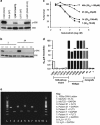The role of the RAS pathway in iAMP21-ALL
- PMID: 27168466
- PMCID: PMC5017527
- DOI: 10.1038/leu.2016.80
The role of the RAS pathway in iAMP21-ALL
Abstract
Intrachromosomal amplification of chromosome 21 (iAMP21) identifies a high-risk subtype of acute lymphoblastic leukaemia (ALL), requiring intensive treatment to reduce their relapse risk. Improved understanding of the genomic landscape of iAMP21-ALL will ascertain whether these patients may benefit from targeted therapy. We performed whole-exome sequencing of eight iAMP21-ALL samples. The mutation rate was dramatically disparate between cases (average 24.9, range 5-51) and a large number of novel variants were identified, including frequent mutation of the RAS/MEK/ERK pathway. Targeted sequencing of a larger cohort revealed that 60% (25/42) of diagnostic iAMP21-ALL samples harboured 42 distinct RAS pathway mutations. High sequencing coverage demonstrated heterogeneity in the form of multiple RAS pathway mutations within the same sample and diverse variant allele frequencies (VAFs) (2-52%), similar to other subtypes of ALL. Constitutive RAS pathway activation was observed in iAMP21 samples that harboured mutations in the predominant clone (⩾35% VAF). Viable iAMP21 cells from primary xenografts showed reduced viability in response to the MEK1/2 inhibitor, selumetinib, in vitro. As clonal (⩾35% VAF) mutations were detected in 26% (11/42) of iAMP21-ALL, this evidence of response to RAS pathway inhibitors may offer the possibility to introduce targeted therapy to improve therapeutic efficacy in these high-risk patients.
Conflict of interest statement
The authors declare no competing financial interests.
Figures




Similar articles
-
The genomic landscape of acute lymphoblastic leukemia with intrachromosomal amplification of chromosome 21.Blood. 2023 Aug 24;142(8):711-723. doi: 10.1182/blood.2022019094. Blood. 2023. PMID: 37216686 Free PMC article.
-
Constitutional abnormalities of chromosome 21 predispose to iAMP21-acute lymphoblastic leukaemia.Eur J Med Genet. 2016 Mar;59(3):162-5. doi: 10.1016/j.ejmg.2016.01.006. Epub 2016 Feb 2. Eur J Med Genet. 2016. PMID: 26836400 Review.
-
Blood Spotlight on iAMP21 acute lymphoblastic leukemia (ALL), a high-risk pediatric disease.Blood. 2015 Feb 26;125(9):1383-6. doi: 10.1182/blood-2014-08-569228. Epub 2015 Jan 21. Blood. 2015. PMID: 25608562 Review.
-
Overexpression of chromatin remodeling and tyrosine kinase genes in iAMP21-positive acute lymphoblastic leukemia.Leuk Lymphoma. 2020 Mar;61(3):604-613. doi: 10.1080/10428194.2019.1678153. Epub 2019 Oct 22. Leuk Lymphoma. 2020. PMID: 31640433
-
B-Cell Acute Lymphoblastic Leukemia with iAMP21 in a Patient with Constitutional Ring Chromosome 21.Cytogenet Genome Res. 2022;162(5):231-236. doi: 10.1159/000527025. Epub 2022 Dec 9. Cytogenet Genome Res. 2022. PMID: 36502796
Cited by
-
Duplex Sequencing Uncovers Recurrent Low-frequency Cancer-associated Mutations in Infant and Childhood KMT2A-rearranged Acute Leukemia.Hemasphere. 2022 Sep 30;6(10):e785. doi: 10.1097/HS9.0000000000000785. eCollection 2022 Oct. Hemasphere. 2022. PMID: 36204688 Free PMC article.
-
Integrating copy number data of 64 iAMP21 BCP-ALL patients narrows the common region of amplification to 1.57 Mb.Front Oncol. 2023 Feb 23;13:1128560. doi: 10.3389/fonc.2023.1128560. eCollection 2023. Front Oncol. 2023. PMID: 36910655 Free PMC article.
-
Genetic Biomarkers and Their Clinical Implications in B-Cell Acute Lymphoblastic Leukemia in Children.Int J Mol Sci. 2022 Mar 2;23(5):2755. doi: 10.3390/ijms23052755. Int J Mol Sci. 2022. PMID: 35269896 Free PMC article. Review.
-
New Challenges in Targeting Signaling Pathways in Acute Lymphoblastic Leukemia by NGS Approaches: An Update.Cancers (Basel). 2018 Apr 7;10(4):110. doi: 10.3390/cancers10040110. Cancers (Basel). 2018. PMID: 29642462 Free PMC article. Review.
-
iAMPlified gene expression offers new insights in B cell precursor leukemia subtype.Leuk Lymphoma. 2020 Mar;61(3):501-503. doi: 10.1080/10428194.2019.1695055. Epub 2020 Feb 3. Leuk Lymphoma. 2020. PMID: 32008406 Free PMC article. No abstract available.
References
-
- Harrison CJ, Johansson B. Acute Lymphoblastic Leukemia. 3rd edn. Wiley-Blackwell: New Jersey, USA, 2009.
-
- Mullighan CG, Goorha S, Radtke I, Miller CB, Coustan-Smith E, Dalton JD et al. Genome-wide analysis of genetic alterations in acute lymphoblastic leukaemia. Nature 2007; 446: 758–764. - PubMed
-
- Case M, Matheson E, Minto L, Hassan R, Harrison CJ, Bown N et al. Mutation of genes affecting the RAS pathway is common in childhood acute lymphoblastic leukemia. Cancer Res 2008; 68: 6803–6809. - PubMed
Publication types
MeSH terms
Substances
Grants and funding
LinkOut - more resources
Full Text Sources
Other Literature Sources
Research Materials
Miscellaneous

